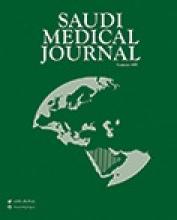REVIEW ARTICLE
A call-to-action from the feedM.E. Middle East study group. Use of a screen-intervene-supervene strategy to address malnutrition in healthcare
The feedM.E. Global Study Group emphasize the importance of routine rescreening for malnutrition risk showing that it can improve patients’ cinical outcomes and reduce healthcare costs. They developed a simple, stepwise Nutrition Care Pathway to facilitate best-practice nutrition care. This pathway guides clinicians to screen patients’ nutritional status on hospital admission or at initiation of care; intervene promptly with nutrition care when needed; and supervene or follow-up routinely with adjustment and reinforcement of nutrition care plans.
see page 903
ORIGINAL ARTICLES
Prevalence and predictors of habitual snoring in a sample of Saudi middle-aged adults
A cross-sectional study was conducted on randomly selected and interviewed employees from randomly selected Saudi Schools. The questionnaire used for the interview included: the Wisconsin Sleep Questionnaire to assess for snoring, medical history, and socio-demographic data. Anthropometric measurements and blood pressure readings were recorded using standard methods. The study reveals that habitual snoring is a common disorder within the Saudi population, and the results suggests a strong association between snoring and hypertension.
Distribution of study population based on snoring habits among subjects included in this study.
see page 920
Thrombus aspiration during primary percutaneous coronary intervention associated with reduced platelet activation
A retrospective study included 413 consecutive ST segment elevation myocardial infarction (STEMI) patients who underwent primary percutaneous coronary intervention (PPCI) and were assigned to the thrombus aspiration (TA) group or the non-TA group. Platelet count and mean platelet volume were obtained at baseline and 24 hours (h), 48 h, and 72 h post PPCI. Manual thrombectomy added to PPCI may reduce platelet activation, which can reduce the incidence of in-hospital ST in patients with STEMI.
see page 935
CASE REPORTS
A novel missense mutation in the TBX5 gene in a Saudi infant with Holt-Oram syndrome
Al-Qattan and Abou Al-Shaar report on a Saudi infant with Holt-Oram syndrome caused by a de novo missense mutation of the TBX5 gene. The mutation (Thr72Lys) is novel and has not been previously reported. The cardiac and limb defects of the patient were both severe, and the infant also had micrognathia and cleft palate. Previously reported cases of the Holt-Oram syndrome caused by missense mutations were reviewed and their phenotypes were compared with the phenotype of their patients.
X-ray of the right upper limb (dorsal view) showing a short radius (arrow) and an absent thumb.
see page 980
- Copyright: © Saudi Medical Journal
This is an open-access article distributed under the terms of the Creative Commons Attribution-Noncommercial-Share Alike 3.0 Unported, which permits unrestricted use, distribution, and reproduction in any medium, provided the original work is properly cited.








